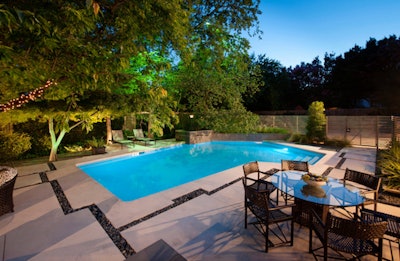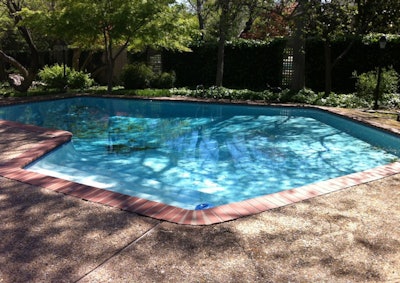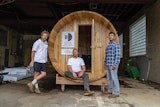
To be successful amid the outdoor living boom, it's critical for retailers and builders to stay abreast of rapidly changing consumer tastes in backyard products. To help keep your product lines up to date, AQUA has partnered with design megasite Houzz to bring you more content about outdoor living, from pools and spas to outdoor kitchens and patio furniture. This time, a Houzz expert explores what it takes to update an older pool design.
If you’ve got a swimming pool that’s 20, 30 or even 40 years old, chances are it might be due for an update. Many of these pools were built of gunite, a mixture of cement, sand and water that was sprayed over a web of reinforcing metal bars, then topped with plaster. The water line was typically lined with tile and topped with coping. Concrete, stone or occasionally wood usually forms the decking that surrounds the pool.
Project: Replaster or remodel a pool and update the surrounding landscaping.
Why: The expected life span of the plaster applied to gunite pools ranges from 10 to 15 years — although good pool chemistry and maintenance may earn you a few years beyond that. When left white, the plaster allows the sky to reflect in the water, giving the water that aqua blue hue that many fondly associate with backyard swimming pools. You can refinish your pool with plaster again, but other choices are available now — and you might want to update the rest of the yard while you’re at it.

Photo by Pool Environments Inc
In remodeling their swimming pool, a Dallas-area couple wanted to retain the bright aqua color they’d always associated with the water.
This pool started out with brick coping and an exposed aggregate deck, popular when the pool was built. It also had a step-out defined by slotted steps in the side of the pool, and two metal handrails visible on the far side, which are not considered as desirable today.

Photo by Pool Environments Inc
AFTER: The plaster was replaced with a fine aggregate mixture that has more tooth than typical plaster, but is not so rough as to be irritating on bare feet. The new concrete decking doubles as the coping and was broken into geometric sections divided by black pebbles. The new raised planter bed forms a backdrop and provides a spot for the fountain that spills a gentle ribbon of water into the pool.
“The exposed aggregate of the original decking was hard on your feet,” says Chris Polito of Pool Environments. “And there are other products with larger aggregate that replace the plaster and are also hard on your feet, so we used a much smaller aggregate product called Wet Edge to replace the plaster.”

Photo by Pool Environments Inc
This 1980s pool had the same materials as the previous example.

Photo by Pool Environments Inc
AFTER: The coping was replaced by Oklahoma flagstone, and a new concrete deck was poured, creating a much more inviting appearance. The concrete was given a coordinating stone texture and was scored to make it look like pavers.
“The lighter color of this stone and decking sheds heat well,” says Polito. The plaster was replaced by a darker aggregate, which also helps to highlight the stone.

Photo by Pool Environments Inc
While the shape of this pool is different from the previous example, its features and finishes are the same.

Photo by Pool Environments Inc
AFTER: Once again flagstone was used for the decking, and there’s now a raised platform that cleverly conceals the original diving board and a pair of strategically placed fountains.
“The kids loved the original slide, so it remained,” says Polito. The shape and 20- by 40-foot size are very common in pools from the 1950s and ’60s. The original gray plaster was replaced with an aggregate mixture that makes the water a beautiful deep-sea blue.

Photo by Pool Environments Inc

Photo by Pool Environments Inc
AFTER: Quite a transformation has taken place with this pool. A spa has been added, and a planter wall continues its height along the back side of the pool, providing a platform for pots and a place for fountains. Notice here that the coping contrasts with the lighter-colored stone of the decking and the water line. Again, the plaster has been replaced with a darker aggregate to give the water lots of depth.
RELATED: Add Outdoor Fountains to Your Pool Today

Photo by Pool Environments Inc
Plant pedestals broke up the rectangular form of this pool, which featured charcoal-colored interior plaster that made the water appear very dark.

Photo by Pool Environments Inc
AFTER: The plant pedestals were removed, restoring the pool’s simple shape, and the pool now has an extra touch of drama thanks to the sculptural fountain rising behind it. The new decking is divided by strips of grass that elegantly soften the space. The pool interior was lightened, brightening the water, which got added drama from new LED lighting.

Photo by Raymond Jungles Inc
Replastering or remodeling your pool is a good project for you if you own a house with an aging pool and are able to invest in updates.
Cost: If you are simply draining out the water and replacing plaster with plaster, you should be able to get it done for $5,000 to $10,000. But pool remodels can run into tens of thousands of dollars, and it’s not uncommon to spend more than $100,000 on an upscale remodel comparable to the ones shown here.
Who to hire: If you want something special, consider starting with a landscape architect. Swimming pool contractors who specialize in pool remodels are your next step. Just be sure they have a significant portfolio of work and references.
RELATED: Find the Best Landscape Architecture Firms Near You
Typical project length: Depending on the complexity of your project, the process will likely take several weeks to complete. To guarantee completion by pool season, be sure to start your planning well in advance.
Permit: It is highly likely that you will need permits for this work. You will quickly discover that your project will involve replacing at least one other component of your pool system, such as filters, heaters, lighting and more.











































